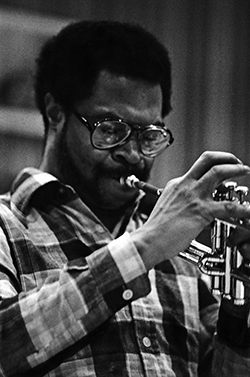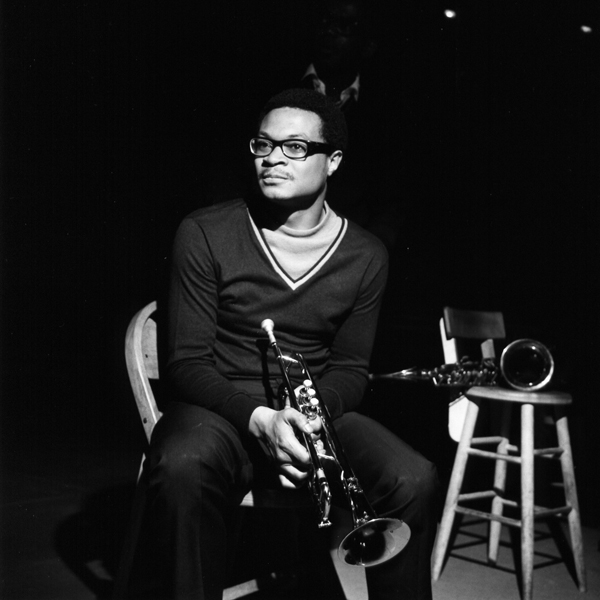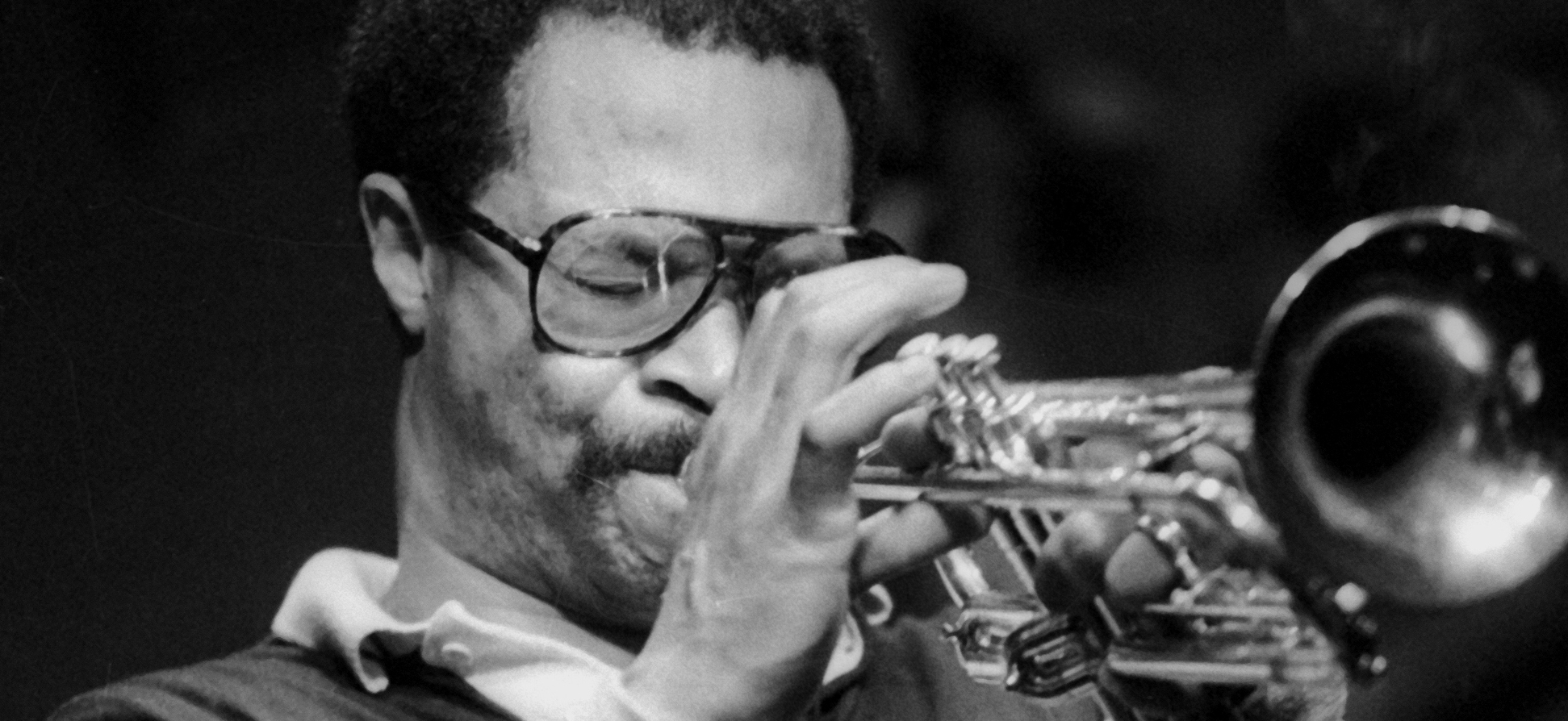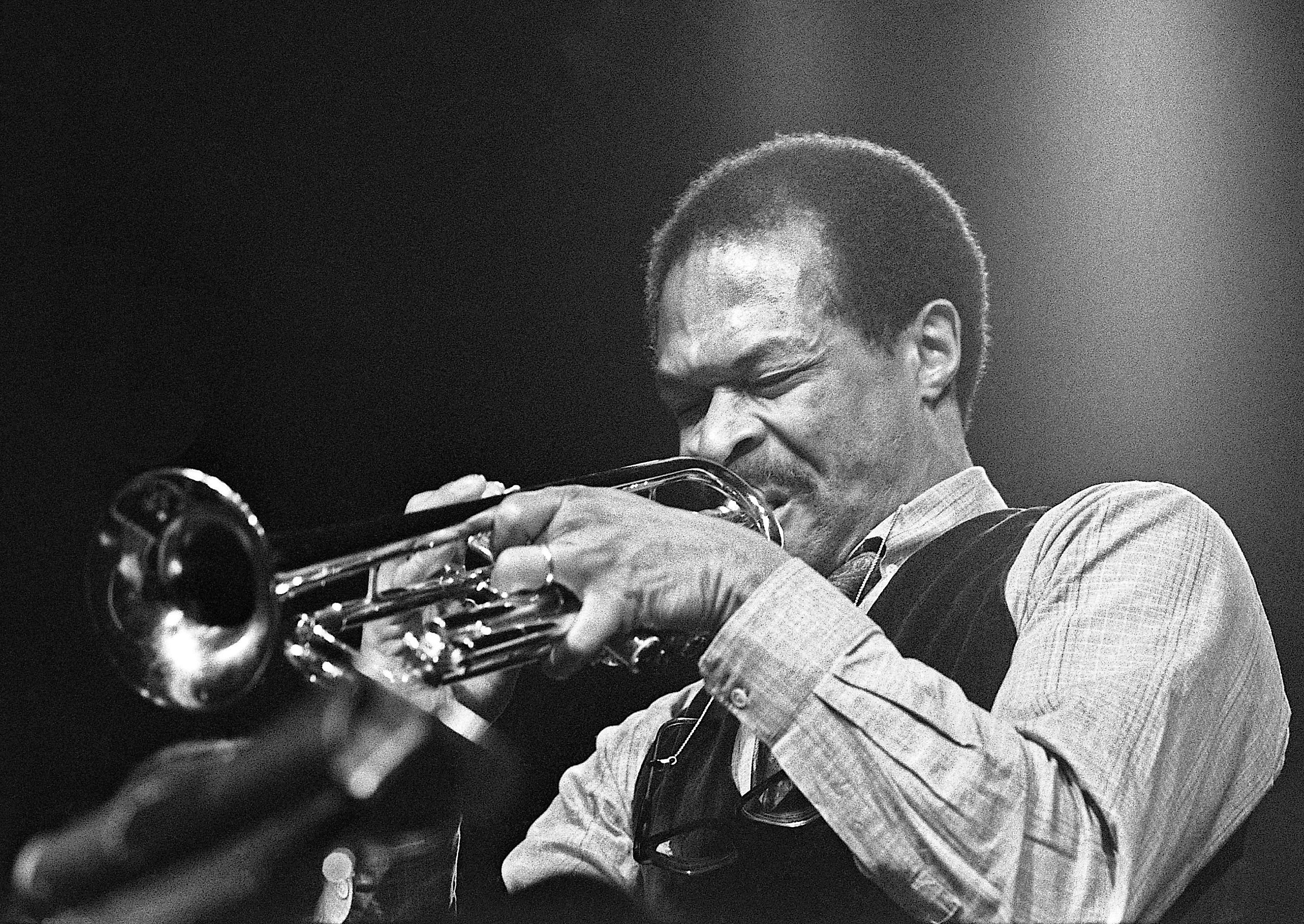Woody Shaw

Woody Shaw, Jr. was born in Laurinburg, NC on Christmas Eve (December 24th), 1944. His father, Woody Shaw Sr., was a lead singer in the legendary gospel group known as the Diamond Jubilee Singers. Woody’s father also attended Laurinburg Institute, which was the alma mater of trumpet legend Dizzy Gillespie. It was to these strong roots that trumpeter-composer Woody Shaw attributed his deep sense of pride, cultural awareness and spiritual devotion to music.
At the age of six months old, Woody Jr.’s parents moved to Newark, NJ where he spent most of his childhood. Woody attended Cleveland Junior High School and joined the Junior Elks, Junior Mason, and George Washington Carver Drum and Bugle Corps where he picked up the bugle at an early age. At Cleveland Junior High School, he met an accomplished trumpet teacher, Mr. Jerome Ziering, and during this time, at age 11, he began studying classical trumpet while listening to Dizzy Gillespie, Louis Armstrong, Harry James, and later Clifford Brown. Mr. Ziering wanted Woody to attend The Juilliard School of Music to become a classical trumpeter so he trained young Shaw to become a virtuoso on his instrument. Although he never reached Juilliard, Woody attended the famed Arts High in Newark, which was attended by many legendary jazz artists, such as Wayne Shorter, Sarah Vaughan, organist Larry Young, and many others. Woody began working professionally at age 14.
Woody sat in with countless musicians as a teenager, including Kenny Dorham, Hank Mobley, Lou Donaldson and others in Newark. Along with playing in the local youth bands, this gave him a solid basis in the jazz and African American musical tradition.
 1960s
1960s
After playing with famed Latin percussionist Willie Bobo in a band with Chick Corea and saxophonist Joe Farrell, Woody joined the band of legendary saxophonist Eric Dolphy in 1963. It was under the tutelage of Dolphy that Woody would be encouraged to pursue his own musical voice. Dolphy’s complex compositions provided Shaw with a new harmonic concept and different way of looking at music which would shape his approach to the trumpet for years to come. In May of 1963, Woody made his first recorded debut on Eric Dolphy’s Iron Man.
In 1964, at age 19, Woody moved to Paris to work with Dolphy’s band, but Dolphy had passed away, so he wound up living there for a year and half while working with people like Bud Powell, Kenny Clarke, Johnny Griffin, Dexter Gordon, Nathan Davis, Donald Byrd, and other expatriates in Europe. While in Paris, Woody received an invitation to return to the U.S. to join the Horace Silver Quintet, and, in 1965, Woody made his first album for Blue Note Records on Horace Silver’s classic – Cape Verdean Blues.
Later that year Woody made what would be his first major recording as a composer and trumpeter on organist Larry Young’s cult classic, Unity, which featured Joe Henderson on tenor sax and Elvin Jones on drums. Woody wrote three of the six tunes on Unity, entitled “Zoltan,” “Beyond All Limits,” and “The Moontrane,” all of which have become standards. The years following would see Woody working as a sideman for Blue Note and touring with such legends as Jackie McLean, Booker Ervin, Hank Mobley, Art Blakey, Max Roach, Andrew Hill, Joe Henderson, Joe Zawinul, Bobby Hutcherson, Herbie Hancock, McCoy Tyner, and many others (see official discography).

1970s
In 1970, Woody made his first album as a leader entitled Blackstone Legacy (Contemporary), which featured Gary Bartz, Bennie Maupin, Ron Carter, and Lenny White. Shortly thereafter, he recorded a second album entitled Song of Songs and around this time moved to San Francisco where he worked closely with Bobby Hutcherson and others, frequenting the famed Keystone Korner club.
In 1974, Woody returned to the East Coast and signed with Muse Records (now High Note) and recorded several albums such as The Moontrane (1974), Love Dance (1975), Little Red’s Fantasy (1976) Live at the Berliner Jazztage (1976), and Iron Men (1977, a tribute to Eric Dolphy and Andrew Hill featuring Arther Blythe, Muhal Richard Abrams and Anthony Braxton). All of Woody Shaw’s Muse recordings were reissued in The Complete Muse Sessions of Woody Shaw in 2013.
In 1976, Woody also made his first major commercial debut for Columbia Records with Dexter Gordon appearing on Dexter’s resurgent album Homecoming (1976), followed by Sophisticated Giant (1977), and Gotham City (1981). In 1977, by way of an endorsement from Miles Davis, and through his association with Dexter Gordon – who Woody had helped reintroduce to the American jazz scene – Woody received his first major record contract and was signed with Columbia Records.
He then went on to record five historic albums of his own: Rosewood (1977), Stepping Stones (1978), Woody III (1979), For Sure (1980) and United (1981). The recent Complete Columbia Albums Collection of Woody Shaw (co-produced and project-directed by his son, Woody Shaw III) showcases all of Woody’s work from this period including additional unissued material. Musicians included on Woody’s Columbia recordings include Victor Lewis, Carter Jefferson, Onaje Allan Gumbs, Clint Houston, Stafford James, Joe Henderson, Rene McLean, Mulgrew Miller, Larry Willis, Steve Turre and others.
 1980s
1980s
Throughout the 1980s, Woody toured with various ensembles which included musicians such as Kenny Garrett (Woody appears as a guest on Kenny Garrett’s debut album Introducing Kenny Garrett), Terri Lyne Carrington, David Williams, Ronnie Burrage, Kirk Lightsey, Ray Drummond, and Cedar Walton. He also recorded a series of albums for Blue Note with his close friend and fellow trumpet legend Freddie Hubbard.
During this period, Woody conducted numerous workshops and clinics around the world. Between the years of 1984 and 1986, Woody traveled all over Europe and to the Middle East and South Asia on the United States Information Service tour where he visited such countries as India, Egypt, the Sudan, and Russia.
After several years of mounting health complications, Woody Shaw suffered fatally from kidney failure and passed away on May 10th, 1989 at the young age of 44. Yet despite a fairly short and challenging life fraught with various health problems, the brilliance of his legacy and the beauty of his music continues to inspire people all over the world. Woody Shaw lives on through his many close friends, students, and thousands of musicians and music lovers who discover, listen to, and explore his life’s work everyday. His legacy is preserved and maintained by his son and namesake, Woody Louis Armstrong Shaw III, who controls all creative, legal, archival and administrative aspects of the Shaw Legacy.
Woody Shaw, Jr. is today considered to be the last major innovator in the lineage of 20th-century trumpet that began with Joe “King” Oliver, Jabbo Smith, Louis Armstrong, and which extended on through the likes of Harry James, Bunny Berigan, Cootie Williams, Roy Eldridge, Dizzy Gillespie, Fats Navarro, Miles Davis, Kenny Dorham, Clifford Brown, Lee Morgan, Booker Little, Donald Byrd, and Freddie Hubbard. Inspired heavily by saxophonists John Coltrane and Eric Dolphy and pianist McCoy Tyner, as well as by various world musics and European classical composers, Woody Shaw sought to extend the legacy of jazz by systematically advancing the tonal, harmonic, melodic, rhythmic and improvisational language of modern trumpet playing. Rooted deeply within the spiritual and intellectual dimensions of both African American and European classical forms (what he termed “Afro-European” musics), and invested in exploring an array of world cultures and systems of thought, Woody Shaw pioneered a new approach to structured improvisational composition in which the totality of his influences would gradually find uncompromising expression.
Musicians whose lives and careers have been directly impacted by Woody Shaw’s work (through interaction, exposure, or direct instruction) include such notables as Wallace Roney, Randy Brecker, Tom Harrell, Dave Douglas, and Terence Blanchard, as well as Wynton Marsalis, Chris Botti, and Ingrid Monson, and countless others, the latter three of whom received grants from the National Endowment of the Arts to study with Woody Shaw during the 1980s.
Originally posted on www.woodyshaw.com/bio
Photo credit:
- Homepage – www.woodyshaw.com
- Above #1 – en.wikipedia.org
- Above #2 – bluenote.com
- Above #3 – npr.org
- Above #4 – usatoday.com

